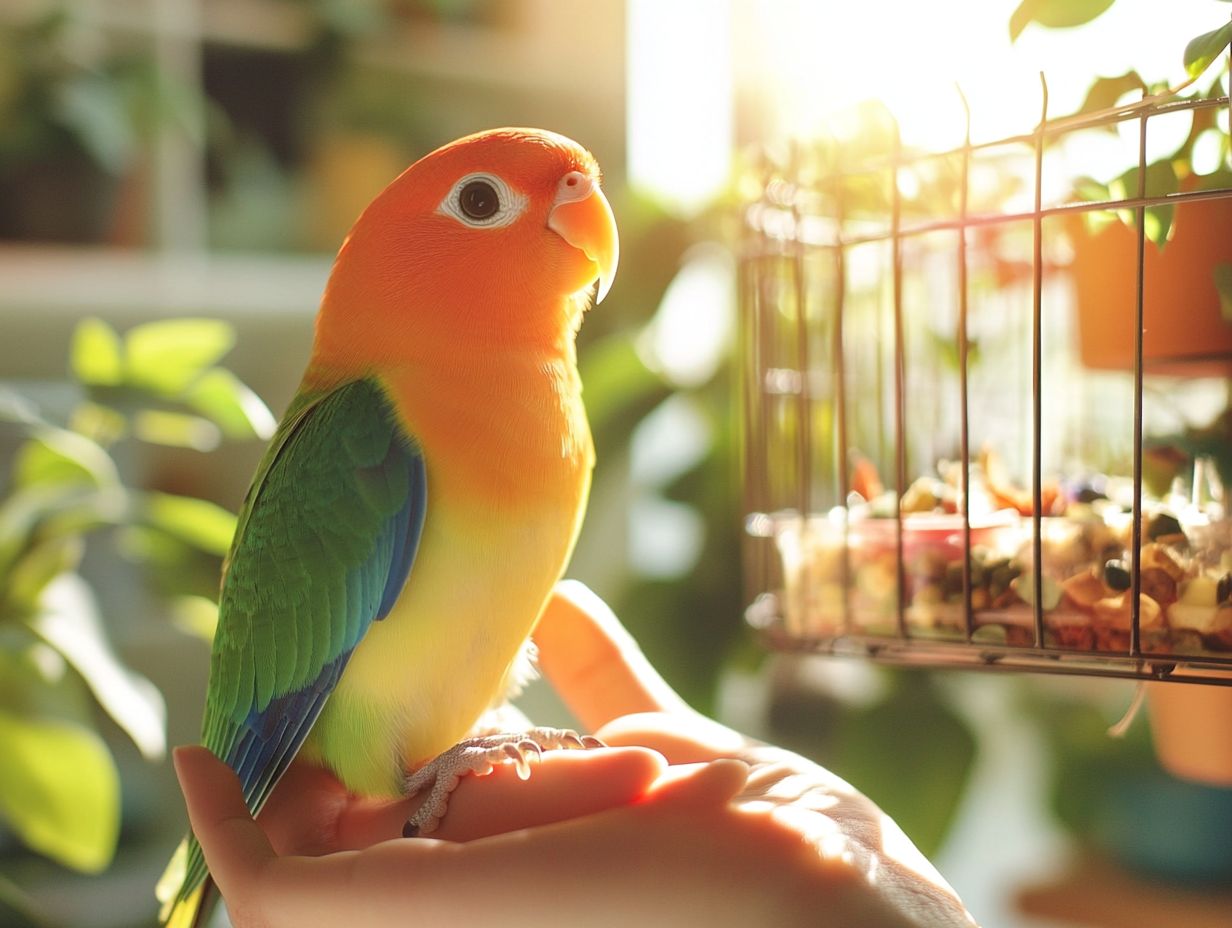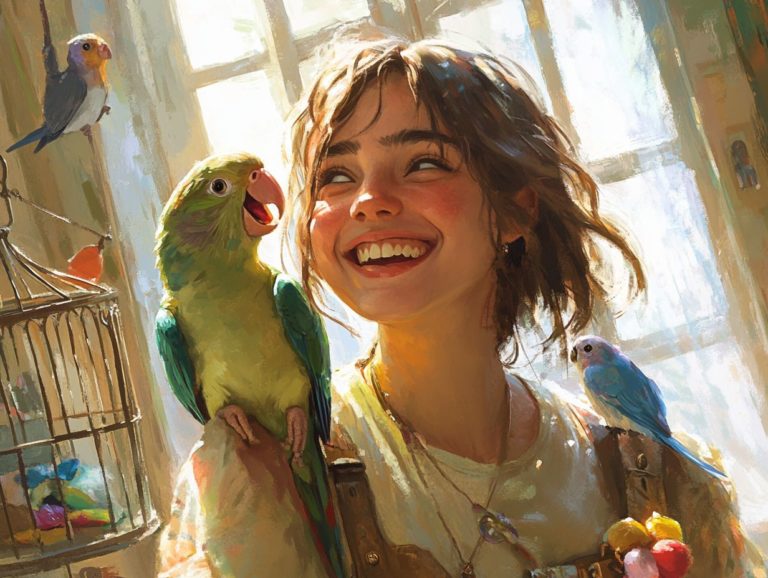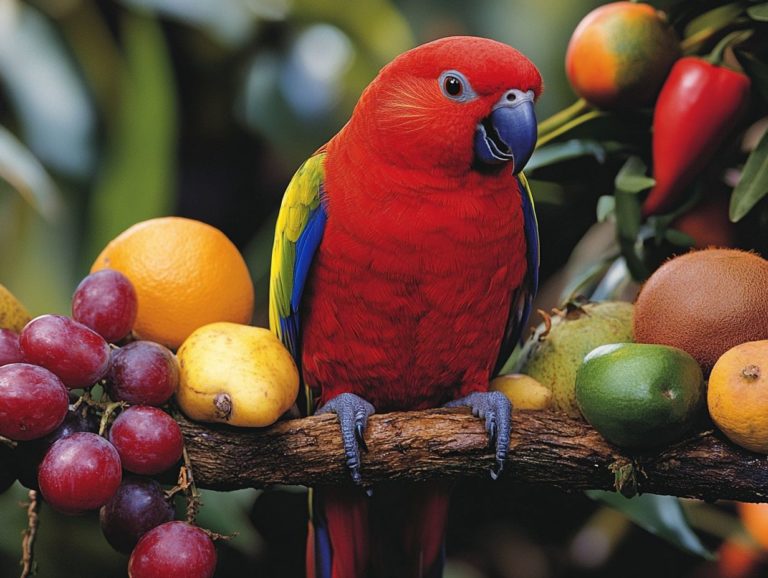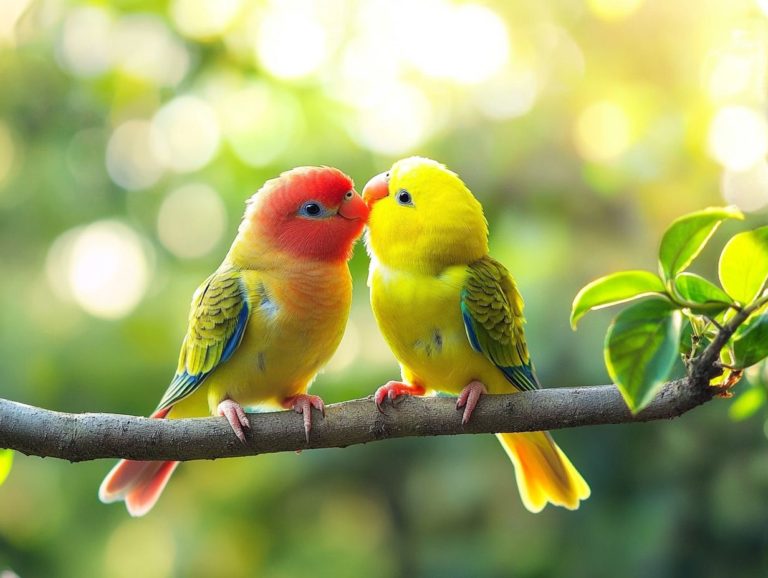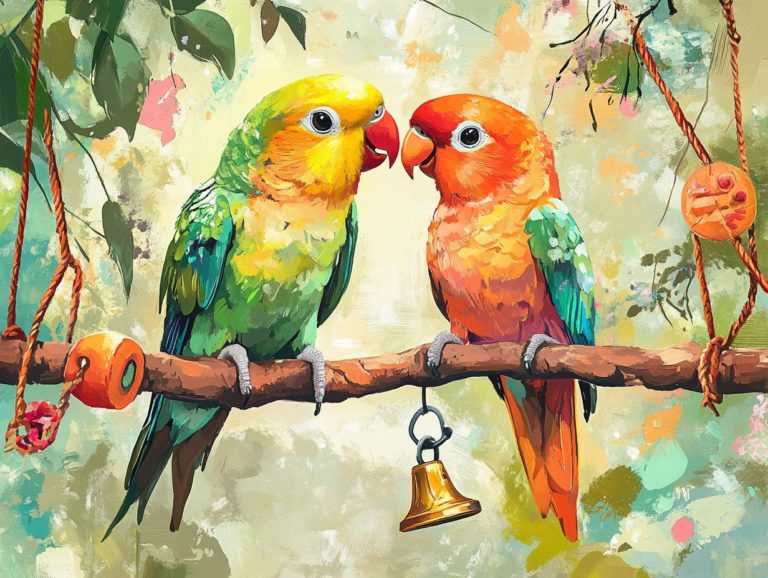Caring for Your Lovebird: A Quick Guide
Lovebirds are delightful, affectionate companions celebrated for their playful personalities and stunning colors. If you re thinking about inviting one into your home, it’s exciting to learn how to care for your new friend! This guide provides all the insights you need, from crafting the ideal living environment and maintaining a balanced diet to ensuring your feathered friend remains healthy and happy.
You will discover techniques for training and bonding with your lovebird. You ll also explore various types available to find the perfect fit for your lifestyle. Dive in to ensure your lovebird flourishes!
Contents
Key Takeaways:
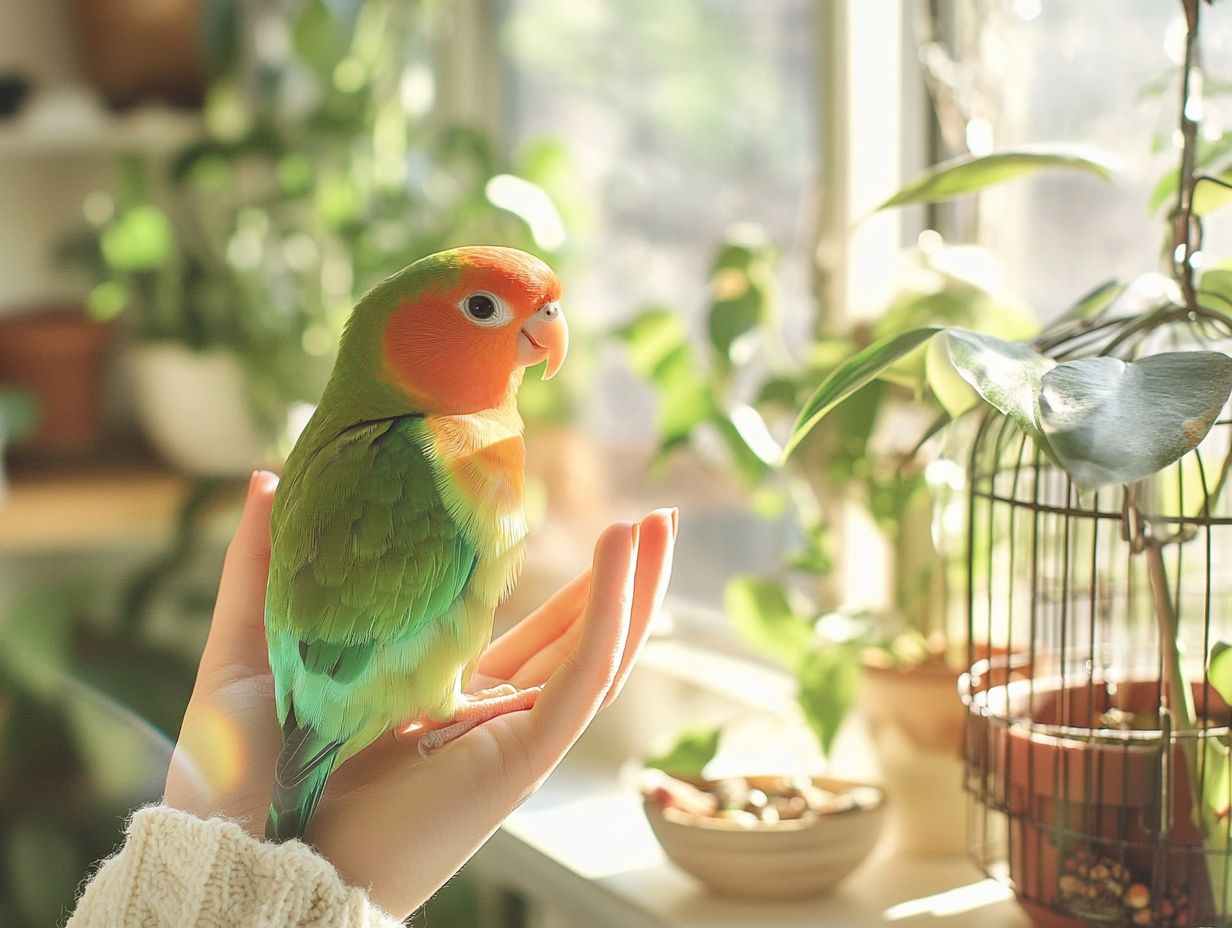
- Provide a spacious and stimulating environment, a nutritious diet, and regular grooming and hygiene for your lovebird’s physical and mental well-being.
- Be aware of common health issues and take preventive measures, such as regular vet check-ups and a clean living space, to ensure your lovebird’s health and wellness.
- Invest time and effort in training and socializing your lovebird to develop a strong bond and teach fun tricks. Carefully consider factors like noise level and compatibility when choosing the right lovebird for you.
What are Lovebirds?
Lovebirds, those small and affectionate parrots from Madagascar, capture the hearts of bird enthusiasts like you all over the globe. These vibrant creatures belong to the Psittacidae family, known for their strong social bonds and playful nature, making them favorites among pet lovers. With several species of lovebirds, each flaunting its unique traits, they have become cherished companions in many households and intriguing subjects for avian aficionados.
You might find insights from researchers like Roger Lederer, a notable figure at California State University, particularly enlightening as they delve into the social behaviors and habitat needs of these delightful birds.
Take, for instance, the Peach-faced lovebird, known for its delightful green plumage and striking peach-colored face. Its friendly demeanor makes it a standout choice for many. Then there s Fischer’s lovebird, which turns heads with its cheerful orange and green hues. These charming birds thrive on regular interaction that boosts their joyful spirit.
Their natural habitat in Madagascar, rich with lush, tropical environments, allows them to engage in flocks, revealing the complexities of their social structures. This is a focus of research that Lederer often highlights, underscoring their need for a stimulating and loving home.
If you’re considering welcoming a lovebird into your life, understanding their social needs is key to creating a vibrant, happy environment for these captivating companions. Similarly, if you’re interested in other birds, check out unique care tips for Quaker parrots to ensure they thrive as well.
Basic Care for Lovebirds
Basic care for lovebirds requires you to grasp their distinct habitat, dietary needs, and maintenance requirements, all essential for their health and happiness as beloved companions. For detailed insights, refer to understanding lovebird nutrition. Ensuring they have the right cage, a stimulating environment, and a balanced diet is vital for their well-being.
These playful little birds thrive on interaction. Providing them with fun toys not only keeps their minds active but also enriches their lives. With attentive care, you can nurture a fulfilling companionship that brings joy to both you and your lovebirds.
Housing and Environment
Creating an optimal housing environment for your lovebirds, including the right lovebird cage, is essential for their well-being and happiness as pets.
To achieve this, choose a cage that is at least 30 inches wide, 18 inches deep, and 18 inches high. This size provides your energetic birds with enough space to flap their wings and move around freely. Ideal locations for their home should be away from drafts and direct sunlight, ensuring a stable and comfortable temperature. Positioning the cage at the heart of your daily household activities promotes social interaction, which is vital for their happiness.
Incorporating natural branches, swings, and foraging toys (toys that encourage birds to search for food) will stimulate their mental and physical health, mimicking the challenges they would face in the wild. Regularly cleaning their habitat and rotating toys keeps them engaged, transforming their living space into a safe and enriching environment.
Start building a joyful life with your lovebird today!
Nutrition and Diet
Feeding lovebirds a balanced and nutritious diet is essential for their overall health and longevity. Your lovebird’s diet should include high-quality pellets, fresh fruits, vegetables, and the occasional seeds to meet their specific dietary needs. Proper nutrition not only supports their health but also brings out their vibrant colors and lively personalities. It’s crucial to prioritize the best food options for your feathered friends!
A well-rounded mix of food is important. A consistent feeding schedule ensures these energetic birds receive their necessary nutrients at regular intervals, preventing problems like overeating or malnourishment. Incorporating a variety of fresh produce think leafy greens and berries introduces vital vitamins and minerals that play a key role in boosting their immune system and encouraging optimal behavior.
It s crucial to recognize that poor nutrition can lead to health issues such as feather plucking or lethargy. This underscores the importance of providing a diverse and balanced diet for your charming companions, ensuring they thrive in your care.
Grooming and Hygiene
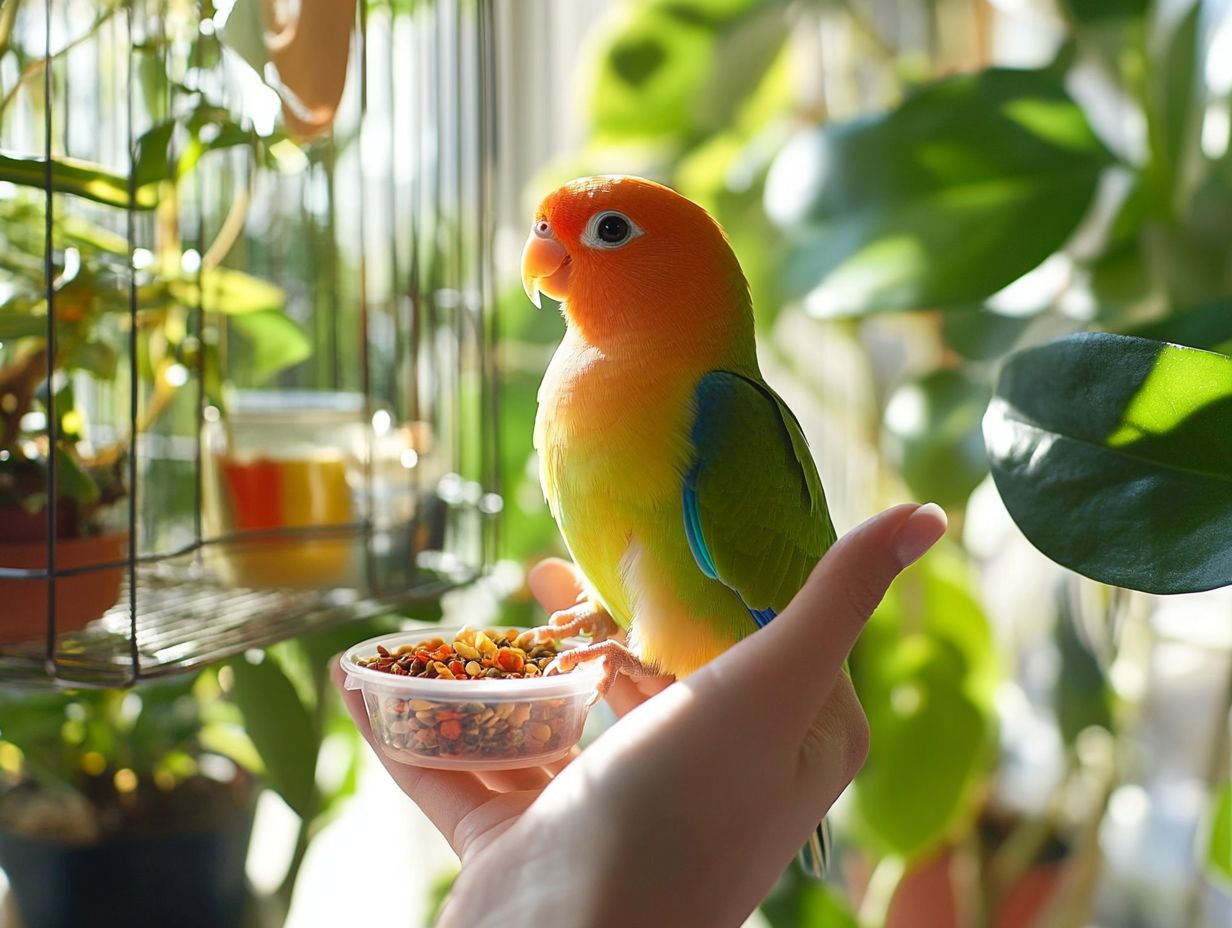
Grooming and hygiene are vital for the health and happiness of your beloved lovebirds. Regular grooming helps keep them clean and healthy. Activities such as giving them bathing opportunities, trimming their nails, and checking for any signs of illness are essential. By setting aside time for their care, you not only prevent potential health issues but also nurture the bond you share with them.
Establishing a consistent bathing routine, ideally once or twice a week, will help keep their feathers in pristine condition and strengthen your connection. Nail trimming should be approached with care every few weeks to avoid overgrowth, which can cause discomfort. Don t delay! Regular inspections for mites, feather loss, and other ailments are essential since these issues can escalate quickly if overlooked.
Maintaining a clean living environment by sanitizing cages and promptly removing waste significantly enhances their overall well-being, allowing your lovebirds to thrive and display their playful, affectionate nature. For those with adopted birds, understanding essential care for adopted parrots is also crucial.
Health and Wellness for Lovebirds
Ensuring the health and wellness of your lovebirds requires a keen eye for common health issues and a commitment to regular check-ups with an avian veterinarian a vet specialized in birds. Diseases like Psittacine Beak and Feather Disease, Polyoma Virus Infection, and Avian Pox Virus Infection can pose serious threats to these delightful creatures.
By proactively recognizing symptoms and scheduling routine veterinary visits, you can significantly enhance your lovebirds’ quality of life and longevity. Learning how to keep your bird healthy and happy ensures they remain vibrant companions for years to come.
Common Health Issues
Common health issues in lovebirds can range from mild annoyances to serious conditions that demand your immediate attention. Among the most critical diseases affecting lovebirds are Psittacine Beak and Feather Disease, Polyoma Virus Infection, and Avian Pox Virus Infection. Each of these presents unique symptoms and treatment requirements. By being aware of these conditions, you enable yourself to act swiftly and provide the necessary care and treatment.
Understanding the specific symptoms of these diseases is crucial for early detection. For instance, Psittacine Beak and Feather Disease often leads to feather loss and a deformed beak, typically caused by a virus. While there s no cure, treatment focuses on supportive care, and good nutrition can significantly aid recovery.
The Polyoma Virus Infection may manifest through sudden death or lethargy, predominantly impacting younger birds. Vaccination is a vital preventive measure you can take to safeguard your feathery friends.
Avian Pox Virus Infection, on the other hand, presents with scabby lesions on the skin, particularly around the face. This condition may require antiviral medications and careful environmental management to limit its spread.
Regular health check-ups and maintaining a clean living environment are essential steps you can take to ward off these potential threats to your beloved lovebirds. Additionally, following preventative care tips for your pet bird can help ensure their well-being.
Preventive Measures
Taking preventive measures is essential for the health and wellness of your lovebirds. Regular visits to a bird vet are crucial.
Routine check-ups catch health issues early. Additionally, maintaining a clean living environment is vital to reduce infection risks and support overall health.
Provide a nutritious and varied diet rich in fruits, vegetables, and high-quality seeds. This diet boosts their immune systems.
Lovebirds thrive on mental stimulation. Engage them with puzzles, swings, and climbing structures to keep their minds sharp and prevent behavioral problems.
Combine these actions with regular social interaction to create a harmonious and thriving life for your charming companions.
Training and Socialization for Lovebirds
Training and socialization are key to building a strong bond with your lovebirds. This enhances their social behavior and enriches your experience as a bird owner.
Use consistent training techniques like clicker training and positive reinforcement to teach your feathered friends fun tricks. This approach nurtures their natural instincts and fosters a trusting relationship.
Teaching Tricks and Bonding with Your Pet
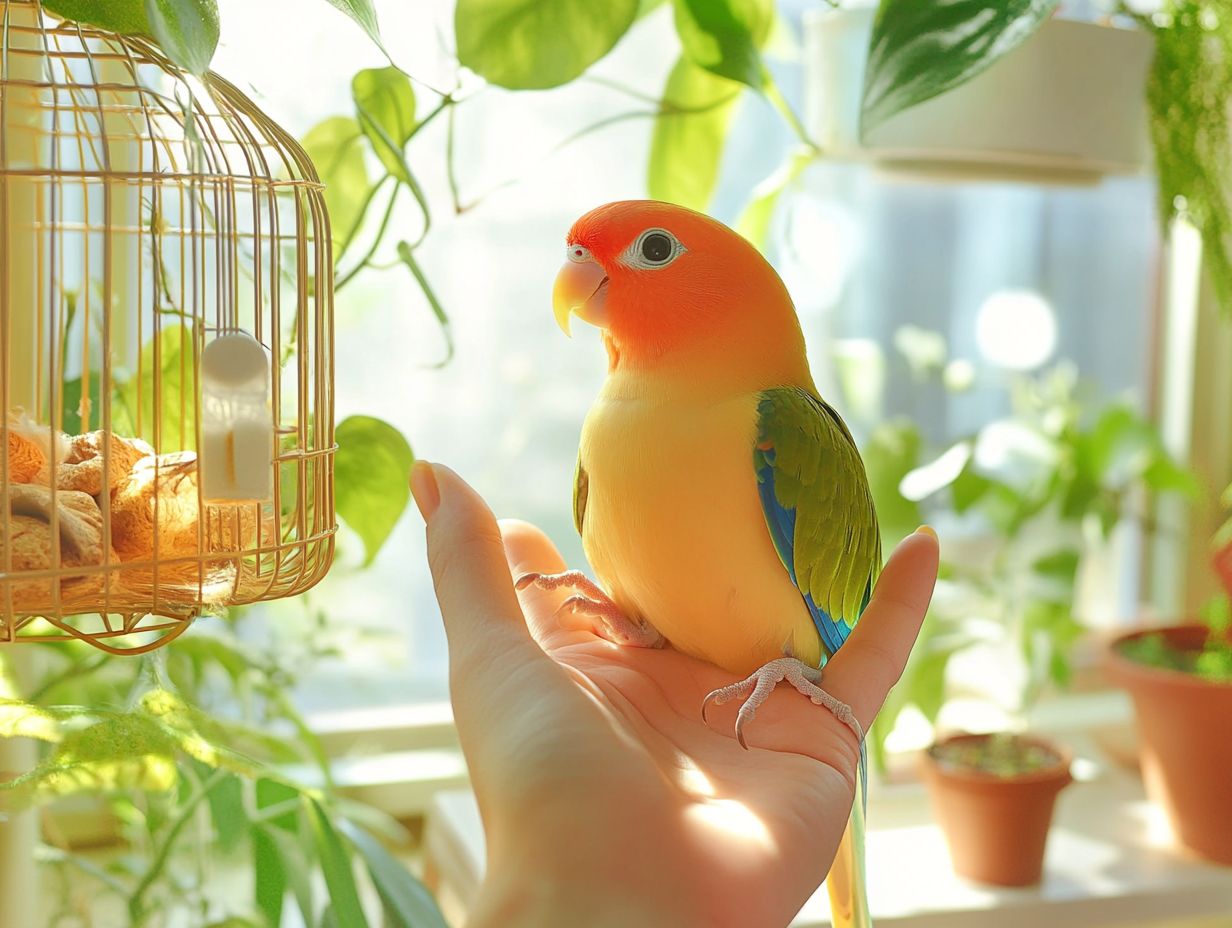
Teaching tricks enhances the bond between you and your feathered companions. It fosters communication and social behavior.
Using techniques like positive reinforcement encourages your pets to perform simple tricks, such as step-up commands or fetching. You’ll share a mutually enjoyable experience that strengthens your relationship.
This fun process stimulates your lovebirds mentally. Training sessions become exciting for both of you.
Keep enthusiasm high during training. Use their favorite treats and opt for short, interactive sessions to maintain focus.
As your lovebirds learn new skills, they become more trusting and expressive. This paves the way for better communication and a richer companionship, enhancing the joy of pet ownership.
Choosing the Right Lovebird for You
Selecting the perfect lovebird is crucial for your journey as a pet owner and your feathered friend’s happiness. Consider factors like temperament, size, and social behavior when choosing.
This thoughtful consideration ensures you select a lovebird that fits your lifestyle and meets your expectations as a devoted bird companion.
Factors to Consider
When selecting a lovebird, focus on several factors for a harmonious relationship. Each species has unique characteristics, including size, temperament, and social behavior.
Understanding these factors helps you make an informed choice that leads to fulfilling companionship.
The age of a lovebird also affects bonding. Younger birds are more adaptable and easier to train, while older ones may have established behaviors.
Individual traits such as shyness or curiosity influence how a lovebird interacts with you and its environment. Recognizing these nuances fosters a deeper bond and ensures both your needs are met.
Types of Lovebirds
There s a delightful array of lovebird species out there, each showcasing unique traits that truly endear them to bird lovers like yourself. Among the most commonly kept are the Peach-faced Lovebird, Fischer’s Lovebird, and the Masked Lovebird. Each shows off unique colors, patterns, and personalities that elevate their status as exotic birds and cherished companions.
Take the Peach-faced Lovebird, for instance. With its vibrant green plumage and rosy face, it s renowned for its playful and affectionate nature.
Then there s Fischer’s Lovebird, which enchants with striking yellow and green feathers. Its joyful demeanor can light up any room you enter.
Let s not forget the Masked Lovebird, distinguished by its charming mask and colorful blend. It s often described as social and intelligent, thriving on interaction and mental stimulation.
These species captivate with their beauty and showcase endearing behaviors, making them delightful pets for those who truly appreciate their lively personalities.
Your Lovebird Questions Answered!
-
What is the best diet for my lovebird?
The best diet for a lovebird includes a variety of fresh fruits and vegetables, high-quality pellets, and occasional treats like seeds or nuts.
-
How do I know if my lovebird is sick?
Symptoms of sickness in lovebirds include changes in behavior, loss of appetite, discharge from eyes or nostrils, and fluffed feathers. If you notice any of these signs, it s best to consult with a veterinarian.
-
Do lovebirds need a companion?
Lovebirds are social birds and thrive with a companion. It’s best to keep them in pairs, but they can also bond with their human caregivers if given enough attention.
-
How often should I clean my lovebird’s cage?
Make sure to clean your lovebird’s cage at least once a week, or more frequently if needed. This helps maintain good hygiene and prevents the buildup of bacteria.
-
Can I train my lovebird to do tricks?
Yes, lovebirds are very intelligent and can be trained to do tricks with positive reinforcement. However, not all lovebirds may be interested in training, so be patient and consistent.
-
Do lovebirds need toys?
Lovebirds are very active birds and need mental stimulation. It’s recommended to provide them with a variety of toys to keep them entertained, including chew toys, swings, and puzzle toys.
Your lovebird will thrive with these tips! Consider visiting local shelters or pet stores to adopt a lovebird or learn more about cockatiel care to ensure a happy and healthy environment for your feathered friends.

